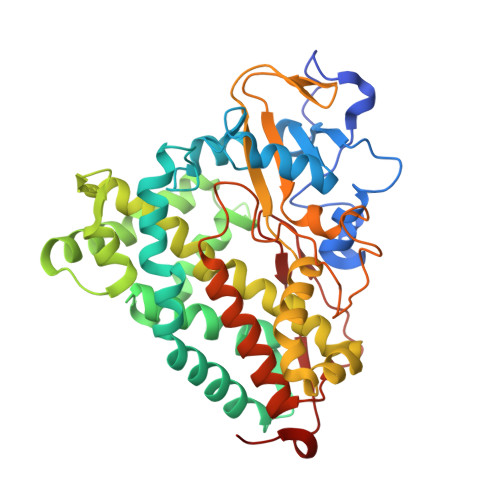Cytochrome P450 active site plasticity: attenuation of imidazole binding in cytochrome P450cam by an L244A mutation.
Verras, A., Alian, A., Montellano, P.R.(2006) Protein Eng Des Sel 19: 491-496
- PubMed: 16943206
- DOI: https://doi.org/10.1093/protein/gzl035
- Primary Citation of Related Structures:
2H7Q, 2H7R, 2H7S - PubMed Abstract:
We have identified a P450(cam) mutation, L244A, that mitigates the affinity for imidazole and substituted imidazoles while maintaining a high affinity for the natural substrate camphor. The P450(cam) L244A crystal structure solved in the absence of any ligand reveals that the I-helix is displaced inwards by over 1 A in response to the cavity created by the change from leucine to alanine. Furthermore, the crystal structures of imidazole-bound P450(cam) and the 1-methylimidazole-bound P450(cam) L244A mutant reveal that the ligands have distinct binding modes in the two proteins. Whereas in wild-type P450(cam) the imidazole coordinates to the iron in an orientation roughly perpendicular to the plane of the heme, in the L244A mutant the rearranged I helix, and specifically residue Val247, forces the imidazole into an orientation almost parallel to the heme that impairs its ability to coordinate to the heme iron. As a result, the imidazole is much more weakly bound to the mutant than it is to the wild-type enzyme. Despite the constriction of the active site by the mutation, previous work with the L244A mutant has shown that it oxidizes larger substrates than the wild-type enzyme. This paradoxical situation, in which a mutation that nominally increases the active site cavity appears to decrease it, suggests that the mutation actually increases the active site maleability, allowing it to better expand to oxidize larger substrates.
Organizational Affiliation:
Department of Pharmaceutical Chemistry, University of California 600 16th Street, San Francisco, CA 94158-2517, USA.















